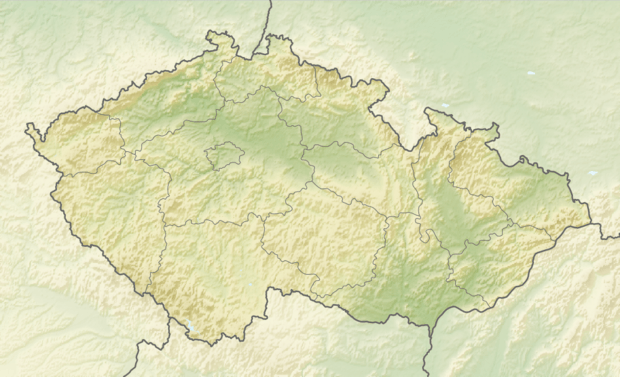Klášterec nad Ohří
Klášterec nad Ohří (Czech pronunciation: [ˈklaːʃtɛrɛts ˈnat oɦr̝iː]; German: Klösterle an der Eger) is a town in the Ústí nad Labem Region of the Czech Republic. The River Ohře runs through the town.
Klášterec nad Ohří | |
|---|---|
Town | |
 Flag  Coat of arms | |
 Klášterec nad Ohří Location in the Czech Republic | |
| Coordinates: 50°23′25″N 13°10′19″E | |
| Country | Czech Republic |
| Region | Ústí nad Labem |
| District | Chomutov |
| First mentioned | 1352 |
| Government | |
| • Mayor | Štefan Drozd |
| Area | |
| • Total | 53.8 km2 (20.8 sq mi) |
| Elevation | 320 m (1,050 ft) |
| Population (2019-01-01[1]) | |
| • Total | 14,533 |
| • Density | 270/km2 (700/sq mi) |
| Time zone | UTC+1 (CET) |
| • Summer (DST) | UTC+2 (CEST) |
| Postal code | 431 51 |
| Website | www.muklasterec.cz |
The town has around 14,500 inhabitants. Parts of the town are affiliated villages Miřetice (now the modern part of the town with a lot of prefabricated houses), Ciboušov, Klášterecká Jeseň, Lestkov, Mikulovice, Rašovice, Šumná, Vernéřov, Hradiště, Kunov, Horní Miřetice, Pavlov, Potočná, Suchý Důl, Útočiště, and Velká Lesná.
History of the town
The town was established by Benedictines from Postoloprty in the 12th century. They built a monastery there, which was destroyed in the 13th century. The village kept the name of Klösterle, i.e. little Kloster in German, and klášter in Czech.
In 1794, the oldest Czech porcelain factory was founded in the Miřetice village, since associated into Klasterec nad Ohri. In the years to come Klášterec nad Ohří grew in importance as one of the earliest European regions of porcelain production and became famous for its porcelain. There is still porcelain production even today under the trade name THUN 1974 a.s. as part of the EPIAG association of various Altrohlau porcelain companies. However, the owner of the original Klášterec nad Ohří Porcelain factory the Prince of Thun und Hohenstein was in 1945 disposed and banished. One of the best modern porn stars, Jane Darling, was born in this town.
Rašovice
Rašovice is a small village on the way to Kadaň on the right bank of the river. It was called Rošovice (after the name of Roch) until 1924. Having been separate until 1961, the village is now part of Klášterec nad Ohří. There are ruins of Lestkov castle above the village.
The village was first recorded in 1443 as a part of the Egerberg domain and with the domain changed holders from Fictums to Lobkowitz of Hasištejn. Bohuslav Felix of Lobkowitz built a castle in the village in 1581 and called it Felixburg. With a new master - Christoph Simon von Thun (cz:Kryštof Šimon), 1623, after the Battle of White Mountain - the village became part of the Thun's domain. St. Anna Church was finished 1837 to replace the previous chapel. In 1871 the villagers rose against the construction of a new bridge over the river, and after a skirmish with the Italian workers they had to be pacified by the army.
The population was 296 in 1863, 587 in 1930 and 104 in 1991.
References
- "Population of municipalities of the Czech republic". Czech Statistical Office. Retrieved 2019-04-30.
- "Partnerská města" (in Czech). Město Klášterec nad Ohří. Retrieved 2019-08-23.